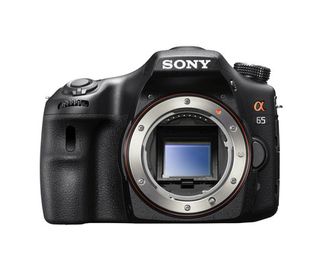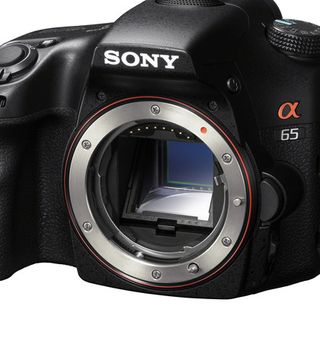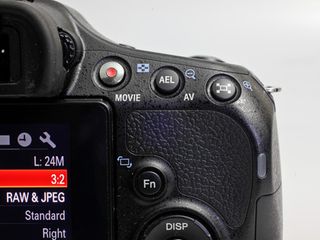TechRadar Verdict
Pros
- +
· Class-leading Full HD movie mode Responsive full-time phase detection AF system
- +
Built-in GPS
- +
Built-in Image Stabilization system (SteadyShot INSIDE)
- +
Highly impressive OLED EVF
Cons
- -
Noise isn't as well controlled compared to rivals
- -
Inclusion of only one control dial hampers manual shooting
- -
Slight delay in registering button presses can be frustrating
- -
Loss of live view feed when shooting in high-speed modes
- -
Two-way LCD design can cause issues with tripod usage
Why you can trust TechRadar
Released alongside Sony's flagship SLT camera – the Alpha 77 – the Alpha 65 may be the 'little brother' to this formidable camera, but it's certainly no less impressive in its own right.
Touted as a slightly pared-down, more affordable alternative to the A77, the new Sony A65 is aimed at enthusiasts looking for a camera that's simple to use, yet with enough features and manual functionality on offer to allow for developing their photography skills without outgrowing it too quickly.
Despite its lower price-point, the A65 shares many of the core high-end features of its pricier sibling, including a high resolution 24.3mp APS-C-sized "Exmor" HD CMOS, top-notch OLED EVF (Electronic Viewfinder), full-time phase detection AF and Live View – to name just a few.
Like the A77, consumer models are yet to make it to the UK, with the disastrous flooding in Thailand resulting in delays to the official release of Sony's latest SLT cameras into the market. For the time-being however, we're pleased to be able to provide a full review of the A65: read on for our verdict on how one of the hottest new contenders to take on the might of the DSLR squares up to the competition.

Features
If you've missed our previous reviews of Sony's innovative SLT cameras, here's a brief explanation of how their design differs from that found inside a traditional DSLR: the latter type of camera incorporates a mirror which reflects light entering through the lens up into a prism, which then resolves the image in the optical viewfinder.
The mirror has to swing out of the way when the photographer presses the shutter release, in order to allow the light to hit the imaging sensor instead and the image to be recorded.
SLT (Single Lens Translucent) cameras incorporate TMT (Translucent Mirror Technology): a translucent mirror that allows most (70%) of the light entering through the lens to pass directly through it and onto the imaging sensor, with a smaller proportion (30%) being reflected up to the camera's phase detection AF sensor. This means that the mirror can remain fixed in place, speeding up the time taken to record a shot and allowing for fast, full-time AF.

There are a few drawbacks to the design: a reduction in the amount of light hitting the imaging sensor increases the potential for low light performance issues and the lack of scope to include an optical viewfinder; although Sony has engineered an innovative solution to the latter, as described in the next section.
In addition to Sony's latest generation SLT core specifications that we've already mentioned, the A65 offers a double-hinged, high resolution LCD that can be tilted away from the back panel and swivelled to accommodate easier shooting at odd angles, plus Full HD (1080p) movie recording with stereo sound (as with the A77), built-in GPS, SteadyShot INSIDE (image stabilisation) and a sensitivity range spanning ISO 100-16000, expandable to include ISO 25600 (in multi-shot NR mode - JPEG only).

The A65 offers a range of creative in-camera effects that let you add distinctive looks to your images without having to go near a computer. Effects on offer include Toy Camera, Pop Color, Posterization: B/W or Color, Retro Photo, Soft High-Key, Partial Color, High Contrast Mono, Soft Focus, HDR Painting, Rich-Tone Mono and Miniature.
Some of the effects also have further options available, allowing you to customise the way they're applied to your shots; for example the Toy Camera effect provides Normal, Cool, Warm, Green and Magenta settings, and you have the opportunity which area of the frame remains in sharp focus when using the Miniature effect. This is a feature that really enhances the range of possibilities open to the creative shooter and offers advanced users a bit more to get their teeth into than the largely fully-automatic modes seen on many of the A65's main rivals.
There are a few features that the A65 lacks in comparison to its big brother, namely an Auto ISO range that's fixed at ISO 100-1600, rather than being customisable, a marginally less rapid 10fps continuous burst mode (rather than the A77's 12fps offering) and a slower maximum shutter speed of 1/4000sec (compared to 1/8000sec).
The A65 also misses out on the superb 19-point AF system with 11 cross-type sensors that the A77 boasts, incorporating a 15-point alternative with just 3 cross-type sensors instead.

These few items aside, the A65 still has a great deal to offer the budding enthusiast looking to upgrade from an entry-level DSLR or compact, with many of the features that it does boast beating those provided by its main rivals. The SLT-A65 certainly looks capable of presenting a serious challenge to its traditional DSLR competitors on paper; but real-world performance is where it really matters. Check out the remaining sections of our review to see how it compares.

